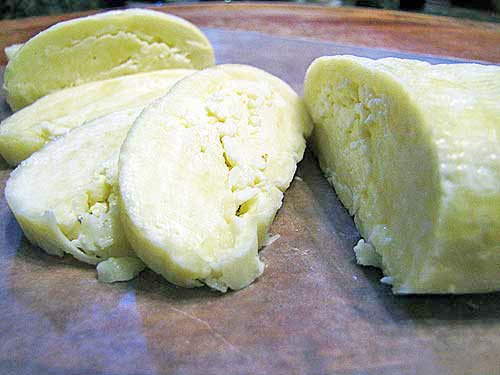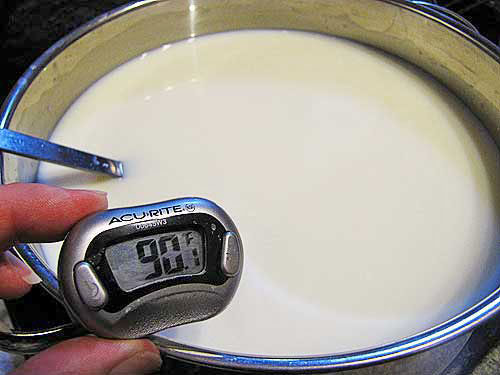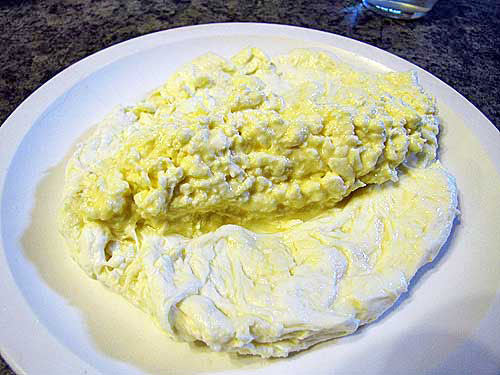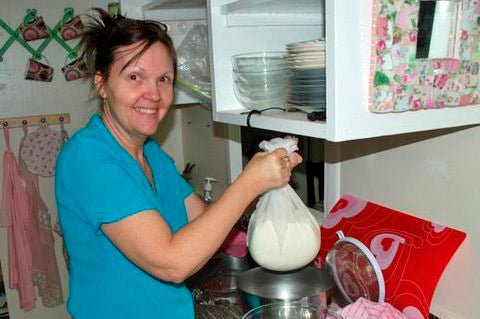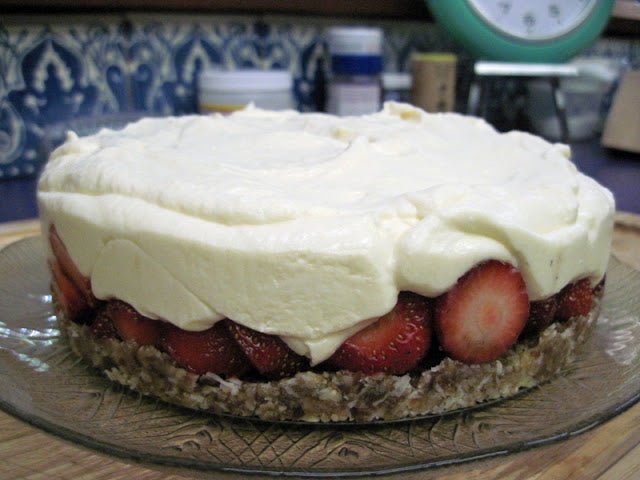Ooooh! Burrata!!!
Suzanne has done it again this month, conquering yet another mouth-watering pasta filata cheese.
Who knew that from the hills of West Virginia, home of Chickens in the Road, would emerge such a fine cheese maker, able to create her own recipe and generous enough to share it with the entire Cheese Queen’s kingdom?
And who knew there would be a giveaway, too? (Well, actually, we all knew that because Suzanne has a fabulous cheese making giveaway every single month.) We really do love you, Suzanne!
30 Minute Burrata
By Suzanne McMinn
https://chickensintheroad.com/cooking/burrata/
Burrata, melted with olive oil and dipping herbs.
Last month, in my quest for a super-soft mozzarella, I made A Cheese of My Own. This month, continuing my cheese challenge for New England Cheesemaking, I’m taking mozzarella in another direction.
Mozzarella is a pasta filata cheese, which means a cheese in which the curds have been stretched or spun. Filata means “spun” and pasta means “paste” in reference to the cheese paste or curds. Burrata is another pasta filata cheese, a softer twin of mozzarella in which one portion of the cheese is stretched while another portion is separated, broken up, mixed with heavy cream, then put back as the filling in a sort of “purse” made of the remaining cheese. You have to work fast and make a tight purse, which can be a little tricky. The softness of this cheese comes from the curd filling–which is not worked much.
This cheese is best made with farm-fresh or local milk, either slow-pasteurized (at 145 degrees for 30 minutes) or used raw. If you’re using pasteurized store-bought milk, add 1/2 teaspoon calcium chloride directly to the milk when you put it in the pot. Do NOT use ultra-pasteurized milk.
Get all your ingredients and equipment out and at the ready.
This burrata recipe is based on Ricki Carroll’s 30-Minute Mozzarella. Artisan cheesemakers make burrata using a traditional mozzarella method (with thermophilic culture etc), so I guess you can call this 30-Minute Burrata!
How to make 30-Minute Burrata:
1/2 teaspoon calcium chloride (only if using store milk)
1 1/2 level teaspoons citric acid dissolved in 1/2 cup cool water
1 gallon whole milk
1/4 teaspoon lipase powder (Italase) dissolved in 1/4 cup cool water (for 20 minutes prior to using)*
1/4 teaspoon liquid rennet diluted in 1/4 cup cool, unchlorinated water
1-2 tablespoons heavy cream
1 teaspoon cheese salt
*Do not add lipase if using milk from the store. It will make your curds too soft.
Step 1. If using store milk, add the 1/2 teaspoon calcium chloride directly to the milk when you put it in the pot. While stirring the milk constantly, add the citric acid solution.
Step 2. Begin heating the milk, continuing to stir, until it reaches 90 degrees.
Step 3. Stir in the diluted lipase. Mix thoroughly then stir in the diluted rennet with an up-and-down motion. If using raw milk, continue heating (stop stirring) the milk to 100-105. Turn off the heat and let sit for 5 minutes before transferring to a microwaveable bowl. I use a glass two-quart bowl with a pour spout.
If using store-bought milk, after adding the rennet at 90, turn off the heat and let sit for 5 minutes. Check the curd. If it’s too soft, let it sit a few more minutes. Cut the curd into 1-inch squares with a knife that reaches the bottom of the pot. Place the pot back on stove and heat to 105 while stirring slowly. Take it off the heat and continue stirring slowly for 2-5 minutes before transferring to a microwaveable bowl.
Curd pulling away from the sides of the pot, revealing the whey:
Here is where we are diverging from the traditional 30-Minute Mozzarella recipe entirely!
Step 4. After pouring off as much whey as you can, separate one-third of the curds.
Place the one-third portion in a colander to drain.
Crumble the one-third portion into small pieces (about thumbnail size).
Drain off any whey that comes out, move it to a small bowl, and add 1-2 tablespoons heavy cream plus 1 teaspoon salt. Mix well to form a creamy cottage cheese-like mixture.
Step 5. Heat the two-thirds portion in the microwave for 1 minute, kneading, stretching, and draining off whey as usual.
Don’t waste all that whey, by the way! Dogs and chickens like it, and I also always put up a quart jar in the fridge to use for bread.
If it’s stretching, you’re ready to move on to the next step. If it’s not stretching yet, heat it again for 30 seconds. (If using raw milk, you probably don’t need to heat it again. It will be stretching already.) Shape/stretch it into a bowl or purse-shape. Place it in a bowl or on a plate.
Step 6. Spoon the curd/cream mixture onto the stretched cheese bowl you’ve made.
Shape and seal the cheese around the filling, tightly pressing it all together. The cheese will want to seal back onto itself.
If you have trouble sealing, reheat the cheese (the whole thing) for another 30 seconds to make it more pliable- then seal.
I wrap mine in cheesecloth after it’s shaped and sealed to help it hold its shape. It may still need to drain for another few minutes. I place the cheesecloth-wrapped cheese on a rack over a plate to drain.
Eat immediately, or chill until firm. The cheese shell will be firm with a soft, rich center.
According to Epicurious, burrata “originated as a way to use up extra curds left over after making mozzarella.” While I made my burrata in one long pouch, it’s often made in small balls in which the pouch is closed and twisted into a knot around the filling. Burrata means “buttered” in Italian, and refers to the heavy cream mixed with the curds in the filling. Burrata is a relative newcomer to the gourmet scene, but you can make it at home!
Note: You will find Suzanne’s giveaway at her website, Chickens in the Road. Good luck!






























